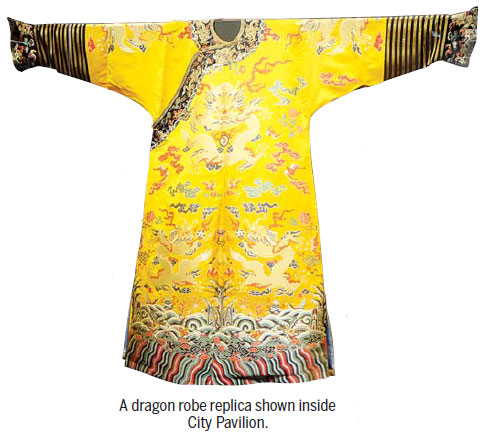
To bring yunjin alive for modern Western audiences, Pan's team decided to present it in three parts, representing its past, present and future.
The past is represented by an exhibition of a dragon robe replica and a live performance of ancient techniques by renowned craftsman Guo Jun.
The dragon robe is traditionally worn by the Chinese emperor, characterized by its elaborate design and large range of colors. The technique is the process that links a drawing to the finished fabric.
The City Pavilion that Nanjing is using has a museum-like setting and is the only pavilion of Milan Expo that is outside the expo center.
To showcase the contemporary relevance of yunjin, Pan's team decided to replicate Italian artist Leonardo da Vinci's famous Mona Lisa using the brocade, so that Western audiences can see a familiar image being created using an ancient Chinese technique.
"When we embarked on this challenge half a year ago, no one knew if it would be a success or not, but we wanted to give it try. But time was very tight, and we had more than 30 craftsmen working around the clock in three shifts to finish it," Pan says.
The finished product uses 70 different types of silk, all of varying colors, to create the depth characteristic of an oil painting. Such a piece of work would typically take one craftsman about 10 years of his life to complete, Pan says.
But the most difficult part is the suspense in the creative process about what the end product will likely be, because yunjin's process of weaving is done while working on the back of a picture, so that no one knows what the picture on the front looks like until it is turned over.
"We finished the entire picture only five days before the opening ceremony of Nanjing Week, and when it was taken off the production line, everyone was curious to see it. It was a very special moment," Pan says.
Also invited to witness the unveiling of the finished work was Xing Jianjian, a professor at the Nanjing University of the Arts, who is an expert in Western oil painting.
"We invited Professor Xing because we wanted an art expert to tell us if we have managed to use yunjin to capture the spirit of Da Vinci's Mona Lisa. He was very much amazed, and said yes we've achieved this impact and that he never knew it would be possible to so accurately represent the essence of Western art using Chinese technique," Pan recalls.




